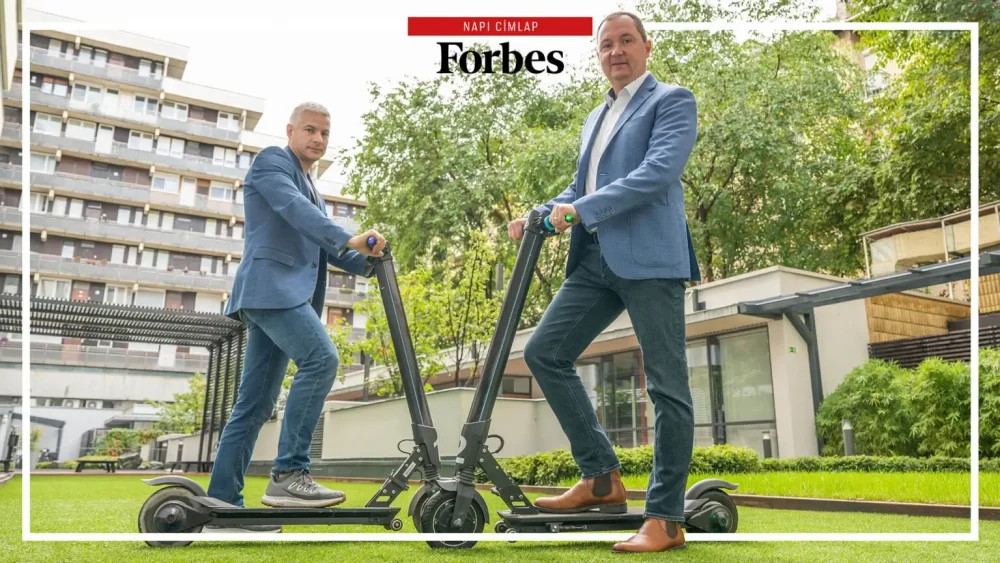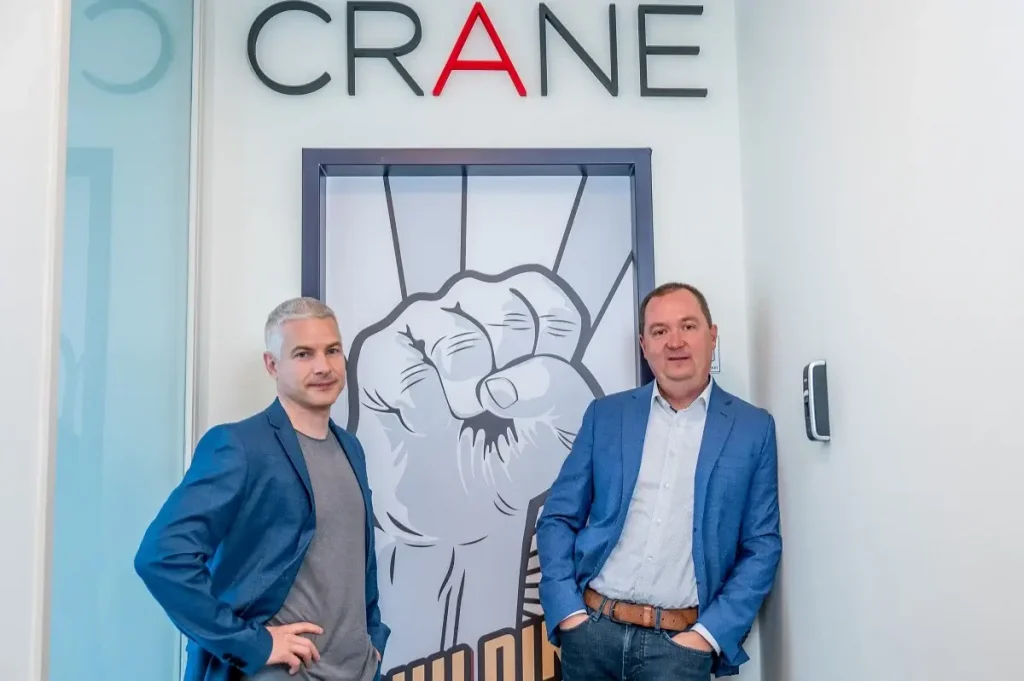They were among the first to embark on the path of data-driven marketing, and today they are optimizing the carbon footprint of emails and newsletters. The company mainly sells for export and its data-based and sustainable solutions are sought after by significant global companies.
“We take it very seriously. Employees must pass an exam before using the scooters,” explains József Bodnár who goes by Jose, about their policy while standing by the e-scooters in the office. Above the scooters, on the wall, colorful graphics explain how to use the machines, and helmets are lined up on the shelves next to them. The tiny vehicles have been in the office for five years now; they were acquired before the scooter revolution in Budapest.
The two founder-owners of Crane, József Bodnár and György Huszics, also arrived at the office building on scooters, and wanted to take their photos with them. For both of them, sustainability is a fundamental issue. In order to the reduce the company’s carbon footprint, they switched to an optional home office system even before the pandemic, and then they created a sustainability business branch for their marketing agency as well. Although this branch still provides only a small slice of their income, it is considered to be particularly progressive in Hungary.
Milán criticized marketing a lot
Their shared history goes way back, György and József were colleagues at McCann (back when it was called McCann Erickson), the Hungarian subsidiary of one of the world’s largest marketing agencies. They explained a lot about how marketing was an entirely different thing in the 90s and in the first half of the 2000s compared to that of today. Marketing activities were not driven by the construction and interpretation of databases, and by well-targeted campaigns based on them. In this respect that age was like the Wild West.
“We were among the first to emphasize building databases, the data-driven approach.”
In 2005, they got to the point of mustering up their courage to start their own company—their way of thinking did not match that of their employer on several professional issues. All they knew was that they wanted to become independent and provide data-driven marketing solutions to the same group of large companies as before, at McCann. “It’s a very serious shift when you suddenly have to finance yourself and you have to give up the comfort of company benefits”, says József.
However, even though both of them were already well-known on the market, customers did not give their trust for free. “With Magyar Posta (Hungarian Post) we had already known each other from earlier, but during the first contract, we did not receive any payment in advance for the work; we had to raise the eight million forints needed for the campaign from family loans.”
They have been partners with Mastercard almost since becoming independent, and when the company was founded, they also worked together with Milán Gauder, who later became the global vice president of the payment-processing corporation. In his own unique style, Milán casually explains, “Gyuri and his colleagues more or less worked in marketing while I was in sales at the company. Like most cool salespeople, I criticized marketing a lot, but you could see that there was something sparkling in their eyes, and they were able to show that I really didn’t get it at all.” Milán also confirms that Crane’s database-based approach was truly unique in the market in the mid-2000s.
“At that time, marketers were thinking about how to spend their budget as fast as possible on television and in newspapers. And Crane wanted to build a foundation that could be used in the longer term. They were pioneers in the systematic collection and organization of customer data.”
Artificial intelligence combing through service data
In addition to Mastercard, Opel and Nissan were also among the first significant customers, both companies bringing a giant spurt in the Crane’s growth. Nissan entrusted them with the advertising campaign of one of its models, the Tiida, as sales of the model slowed down in what’s often referred to as the Visegrád region, enclosing the Czech Republic, Hungary, Poland, and Slovakia. The company did not want to boost their sales using classic media solutions, to advertise without targeting, so they decided to try Crane’s direct marketing methods. “We were working with targeted emails and phone calls which was not common at the time,” says József. “Clearly we couldn’t do anything about the product, but we managed to mobilize the market and revive interest in the model.” Crane’s methodology eventually became a European best practice at the company. At the beginning of the 2010s, the long-term assignment for the coordination of Opel’s CRM (customer relationship management) for 14 countries gave the company a huge boost. This was the time when they moved to a larger, representative environment from the small office that could only fit a few people.
They embraced data-driven thinking so much that they both completed a data science training at the Kürt Academy. They were also progressive enough to include artificial intelligence in the interpretation of databases. A good example of this is a project with Opel: the company wanted to know why consumers choose one service center to the other and the reasons of attrition. “In a case like this, they give us a lot of data about service centers, repairs and consumers, and we run our algorithms on these databases.

György Huszics: “Environmentally conscious marketing increases costs, but also efficiency.” Photo: László Sebestyén (Forbes)
“We can filter by a wide range of parameters affecting consumer decisions, in this case starting from the location of the service station, available service appointments, spare parts, all the way to inflation and weather patterns, even to the subject of public discourse or factors such as what Forbes is writing about.”
When interpreting databases, artificial intelligence is basically used for data cleaning, interpretation, and predictions.
During the interview, the concept of GDPR came up many times, as the general, EU-level data protection regulation made the job of companies building consumer databases considerably more difficult. The founders of Crane reveal a lot about the kind of tools companies used in the past. “The simplest method was to have consumers share their data with us as part of a promotion in the supermarket. But we also bought similar databases from the Ministry of Interior of Hungary.”
They even purchased data from the Ministry of Interior
Today, due to the GDPR regulation, managing and processing customer data is much more difficult, and similar purchases do not occur anymore. “In any case, the big advantage of the GDPR is that it brought uniform, EU-level regulation, while previously the system was highly fragmented,” says György. “And it’s also a great advancement that while before a company only had two legal grounds for data management, according to the new regulation there are now seven of them, so regulators have realized why it is important to collect data.” The duo also welcomes the fact that EU-level regulation is already being prepared for the regulation of artificial intelligence.
“Europe is not doing great in the field of AI, but it is doing great in its regulation.”
The next pioneering story of Crane is connected to sustainability: the company makes the carbon footprint of marketing activities, websites, and newsletters calculable. There is a great site, Website Carbon, which measures how much electricity it costs to load a given web page, and different countries’ averages show the amount of emissions that are involved in producing that energy. Then Crane provides concrete plans on how to transform the website so that its appearance does not change significantly, but the carbon footprint caused by its loading becomes much smaller.
“We don’t deal with energetics, we can’t measure emissions, we use averages accepted by the industry,” says György. If we run a search on Forbes.hu, we get the result that each website load results in the emission of 2.76 grams of carbon dioxide equivalent. And if we multiply this amount by the number of visitors, we can calculate how much emissions we burden the environment with in a month.
By playing with font sizes, colors, and image sizes, a significant reduction can be achieved without any major changes in the appearance of the website.
A single email generates 50 grams of carbon dioxide
The other focus area is the newsletter. On one hand, Crane’s algorithms, boosted with artificial intelligence, are able to examine the parameters that affect the opening of newsletters, like they did for Müpa Budapest in a joint project. “We can examine 180 inputs and parameters on the basis of which the newsletters are opened. In the end, we chose 20 that could be best interpreted.”

József Bodnár: “It’s a very serious shift if you suddenly have to finance yourself.” Photo: László Sebestyén (Forbes)
Then, as in case of websites, they can also measure the carbon footprint through the energy consumption of sending out and opening a newsletter. “Sending a 2.5-megabyte email results in 50 grams of emissions. 320 billion emails are generated each day in the world, and this number is increasing by 4-5 percent per year. Each newsletter pollutes in two separate places: it has to be sent out and then it has to be opened. You can’t do anything about the actual sending process: no matter the amount of emissions it generates, it must be offset. But if we can accurately measure and even predict in advance how many newsletters will not be opened, we can save a considerable amount of emissions.” The team of Crane can also transform the newsletters in a way that their carbon footprint becomes substantially reduced.
Both methods have already been tested at Mastercard in Hungary. As Réka Szalkai, the company’s marketing director describes, Mastercard and Crane have been working together for more than ten years, and they had already started discussing the reduction of their digital footprint last year, but the pilot only started a few months ago. “We were disheartened to see how high the emissions of our website were. Our company not only wants to talk about sustainability, but has made it part of our brand values, and we want to do our best to reduce our carbon footprint as much as possible. A website loads all images and videos regardless of whether you want to view them or even scroll down far enough to see them.”
Crane has already transformed the website of the Hungarian Mastercard, so the emissions associated with one site loading can be reduced by approximately 20-25 percent on an annual basis. Now they are working on the newsletter that is sent out biweekly, where they expect a roughly 20 percent drop in emissions as well. “You can imagine how long it takes for a company as deliberate as Mastercard to have the US management approve a change to a regional website,” explains Réka.
“But environmental awareness harmonizes so well with our values that they managed to make a decision in an accelerated procedure. And now I’m taking the method to the regional level, maybe even higher.”
The fact that Crane mainly sells its services abroad shows how receptive the domestic business sector is to data-based, AI-supported, or even environmentally conscious solutions. In terms of their revenue, export sales consistently exceed domestic sales every year, and their most significant foreign partner is Mastercard. “Environmentally conscious marketing increases costs, but also increases efficiency,” says György. “If we could save just one tenth of those 320 billion emails per day, we would already be doing a lot. We do not just want to talk about sustainability, we really think this is an exceptionally important issue.”
This article originally appeared on Forbes.hu and was written by Gábor Topolay. You can find the Hungarian version here.









Comments are closed.